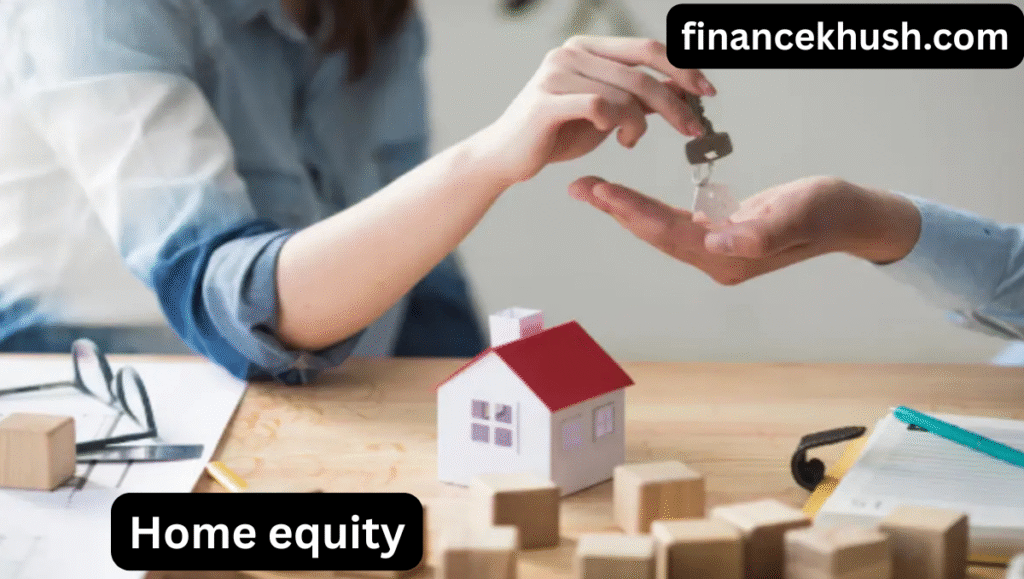Home Equity is the portion of your home that you truly own, calculated by subtracting the remaining mortgage balance from your home’s current market value. Over time, your home equity increases as you pay down your mortgage or if your home’s value appreciates. Home equity can be a powerful financial tool, allowing you to borrow against it for home improvements, debt consolidation, or other financial needs. However, it’s important to use it wisely, as borrowing too much can put your home at risk. Understanding your home equity is key to making informed financial decisions.
What is Home Equity?
Home-equity is the portion of your property that you truly “own.” It represents the value of your home that is not encumbered by debt. For example, if your home is valued at $300,000 and you owe $150,000 on your mortgage, your home-equity is $150,000. The formula to calculate home-equity is straightforward:
Home-Equity = Current Market Value of the Home – Remaining Mortgage Balance
Over time, your home-equity can increase in two ways:
1: Through mortgage payments: As you make regular payments on your mortgage, the amount you owe decreases, which increases your equity.
2: Through an increase in home value: If the real estate market is strong and your home’s value appreciates, your equity grows as well.
How Home-Equity Builds Over Time
Building home-equity isn’t an instant process—it happens gradually over time. The speed at which you build equity depends on several factors:
- Your mortgage payments: Every time you pay your mortgage, part of it goes towards reducing the loan balance. Early on in your mortgage term, most of your payments go towards interest rather than principal, but as time goes on, more of your monthly payments contribute to building equity.
- Home value appreciation: As the value of your home increases due to market conditions, your equity increases as well. In regions where the housing market is thriving, home prices can rise significantly, boosting the homeowner’s equity.
- Home improvements: Renovating your home can also increase its value, which in turn increases your equity. For example, updating a kitchen or adding another bedroom may raise the resale value of your home.
- Paying down your mortgage faster: Some homeowners choose to make extra payments towards their mortgage principal, which can speed up the process of building equity. By doing this, you can reduce the length of your loan and build equity at a faster rate.
Types of Home Equity Loans
Home-equity can be a useful financial tool when you need cash for various reasons. Here are some ways you can tap into your home-equity:
- Home-Equity Loan: A home-equity loan is a lump-sum loan based on the amount of equity you’ve built in your home. Typically, this loan comes with a fixed interest rate and a set repayment schedule. This option is ideal for those who need a large amount of money for a specific purpose, such as home renovations or debt consolidation.
- Home-Equity Line of Credit (HELOC): A HELOC is a revolving line of credit that allows you to borrow up to a certain limit based on your home-equity. It’s similar to a credit card in that you can borrow, repay, and borrow again. HELOCs generally have variable interest rates and are ideal for those who need ongoing access to funds over time, such as for medical bills or college tuition.
- Cash-Out Refinance: A cash-out refinance involves refinancing your existing mortgage with a new loan for a higher amount than you currently owe. You take the difference in cash and use it as you please. This option is beneficial if you want to secure a lower interest rate on your mortgage while accessing extra cash.
Each of these options has pros and cons, and it’s important to assess your financial situation before deciding which one is right for you.

How to Leverage Home-Equity for Financial Growth
While home-equity is often viewed as a safety net, it can also be a powerful tool for financial growth. Here are some ways to leverage your home-equity:
- Investing in Real Estate: If you have significant equity in your home, you could use a home-equity loan or HELOC to invest in another property. This is a common strategy for individuals who want to build wealth through real estate.
- Paying Off High-Interest Debt: If you have credit card debt or personal loans with high-interest rates, you can use your home-equity to consolidate these debts at a lower rate. This can save you money on interest over time and help you get out of debt more quickly.
- Funding Education: If you or a family member is pursuing higher education, you can use your home-equity to pay for tuition and other expenses. With education costs rising, using your home-equity for this purpose can be a wise investment in the future.
- Home Renovations: By using your home-equity to fund home improvements, you increase the value of your home, which can further increase your equity. Plus, you’ll be living in a space that’s better suited to your needs.
- Retirement Planning: In some cases, homeowners use their equity as part of their retirement strategy. A reverse mortgage, for example, allows homeowners 62 or older to convert their home-equity into monthly payments without having to sell their home.
While leveraging your home-equity for growth can be a great strategy, it’s essential to proceed with caution. Any loan or line of credit based on your home’s value puts your property at risk. If you can’t repay the loan, your home could be foreclosed upon.
Risks of Using Home-Equity
While home-equity can offer great benefits, it’s important to be aware of the risks involved:
- Foreclosure Risk: The biggest risk of using home equity is the potential to lose your home if you can’t repay the loan. Unlike other types of loans, a home-equity loan or HELOC is secured by your property. Failing to make payments can lead to foreclosure.
- Overextending Your Borrowing: It can be tempting to borrow against your home equity, especially if the interest rates are lower than other types of loans. However, it’s important to borrow responsibly. Overextending yourself can lead to financial strain, especially if interest rates increase or your home’s value decreases.
- Variable Interest Rates: Some home equity products, like HELOCs, come with variable interest rates. This means your payments could increase over time, especially if market interest rates rise.
- Reduced Home-Equity: Tapping into your home equity reduces the amount of ownership you have in your home. If you borrow too much, it can take years to rebuild your equity, leaving you with less wealth in the future.
How to Increase Your Home-Equity
If you’re looking to increase your hom- equity, here are a few strategies:
- Pay More Than the Minimum: Making extra payments toward your mortgage principal can help build equity faster. Even small additional payments can make a significant difference over time.
- Renovate Strategically: Certain home improvements can boost the value of your home and, in turn, increase your equity. Focus on renovations that provide a high return on investment (ROI), such as kitchen or bathroom remodels.
- Avoid Taking on New Debt: Adding more debt to your finances, such as new loans or credit card balances, can limit your ability to build equity. Focus on paying down existing debt instead.
- Wait for Property Appreciation: If you’re not in a rush to access your home-equity, waiting for the market to appreciate can help. Housing markets tend to fluctuate, and waiting for the right time can significantly increase your equity.

Conclusion
Home equity is more than just a number—it’s a valuable asset that can play a significant role in your financial future. By understanding what home equity is, how it builds, and how to leverage it responsibly, you can unlock financial opportunities and achieve your goals.
Read more
While using home equity can be a great strategy for financial growth, it’s essential to approach it carefully. Always consider the risks and weigh your options before making a decision. By using home equity wisely, you can enhance your financial well-being and set yourself up for long-term success.
Here are top 6 best faq’s
1. What is home-equity?
Home equity is the difference between your home’s current market value and the remaining amount you owe on your mortgage. It represents the portion of the property that you truly own. As you pay down your mortgage or as your home value increases, your home-equity grows.
2. How can I build equity in my home?
You can build equity in your home by making regular mortgage payments, which reduce the amount you owe. Additionally, if your home increases in value due to market trends or home improvements, your equity will grow. Paying down your mortgage faster or renovating your home can also increase equity.
3. What are home equity loans and HELOCs?
A home equity loan is a lump sum loan that uses your home-equity as collateral, with fixed interest rates. A HELOC (Home-Equity Line of Credit) works like a credit card, allowing you to borrow up to a certain limit and pay it back over time, often with variable interest rates.
4. Can I use my home-equity to pay off debt?
Yes, you can use your home-equity to consolidate high-interest debts through a home-equity loan or HELOC. This can help you lower your overall interest rates and make paying off debt more manageable. However, remember that your home is at risk if you don’t repay the loan.
5. Is it safe to borrow against my home-equity?
Borrowing against your home-equity can be useful, but it’s important to be cautious. If you borrow too much or fail to make payments, you risk losing your home. Always borrow responsibly and ensure you can afford the monthly payments before tapping into your home equity.
6. How do I access my home-equity?
You can access your home-equity through a home equity loan, HELOC, or cash-out refinance. Each option has different terms, so it’s important to compare them and choose the one that best fits your financial situation and goals.
